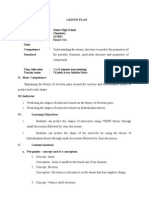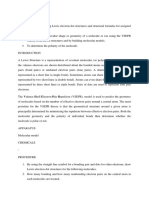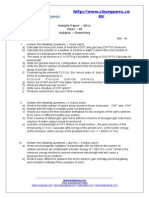Chemistry Reviewer
Chemistry Reviewer
Uploaded by
Rodelyn CadaoCopyright:
Available Formats
Chemistry Reviewer
Chemistry Reviewer
Uploaded by
Rodelyn CadaoOriginal Title
Copyright
Available Formats
Share this document
Did you find this document useful?
Is this content inappropriate?
Copyright:
Available Formats
Chemistry Reviewer
Chemistry Reviewer
Uploaded by
Rodelyn CadaoCopyright:
Available Formats
What is VSEPR Theory?
The Valence Shell Electron Pair Repulsion Theory abbreviated as VSEPR theory is
based on the premise that there is a repulsion between the pairs of valence
electrons in all atoms, and the atoms will always tend to arrange themselves in a
manner in which this electron pair repulsion is minimalized. This arrangement of the
atom determines the geometry of the resulting molecule.
Postulates of VSEPR Theory:
The postulates of the VSEPR theory are listed below
In polyatomic molecules (i.e. molecules made up of three or more atoms),
one of the constituent atoms is identified as the central atom to which all
other atoms belonging to the molecule are linked.
The total number of valence shell electron pairs decides the shape of the
molecule.
The electron pairs have a tendency to orient themselves in a way that
minimizes the electron-electron repulsion between them and maximizes the
distance between them.
The valence shell can be thought of as a sphere wherein the electron pairs
are localized on the surface in such a way that the distance between them is
maximized.
Should the central atom of the molecule be surrounded by bond pairs of
electrons, then, the asymmetrically shaped molecule can be expected.
Should the central atom be surrounded by both lone pairs and bond pairs of
electrons, the molecule would tend to have a distorted shape.
The VSEPR theory can be applied to each resonance structure of a molecule.
The strength of the repulsion is strongest in two lone pairs and weakest in two
bond pairs.
If electron pairs around the central atom are closer to each other, they will
repel each other. This results in an increase in the energy of the molecules.
If the electron pairs lie far from each other, the repulsions between them will
be less and eventually, the energy of the molecule will be low.
Limitations of VSEPR Theory:
Some significant limitations of the VSEPR theory include:
This theory fails to explain isoelectronic species (i.e. elements having the
same number of electrons). The species may vary in shapes despite having
the same number of electrons.
The VSEPR theory does not shed any light on the compounds of transition
metals. The structure of several such compounds cannot be correctly
described by this theory. This is because the VSEPR theory does not take
into account the associated sizes of the substituent groups and the lone pairs
that are inactive.
Another limitation of VSEPR theory is that it predicts that halides of group 2
elements will have a linear structure, whereas their actual structure is a bent
one.
Predicting the Shapes of Molecules:
The following steps must be followed in order to decide the shape of a molecule.
The least electronegative atom must be selected as the central atom (since
this atom has the highest ability to share its electrons with the other atoms
belonging to the molecule).
The total number of electrons belonging to the outermost shell of the central
atom must be counted.
The total number of electrons belonging to other atoms and used in bonds
with the central atom must be counted.
These two values must be added in order to obtain the valence shell electron
pair number or the VSEP number.
What is VSEP Number?
The VSEP number describes the shape of the molecule, as described in the table
provided below.
VSEP Number Shape of the
Molecule
2 Linear
3 Trigonal Planar
4 Tetrahedral
5 Trigonal Bipyramidal
6 Octahedral
7 Pentagonal
Bipyramidal
What is the premise of the VSEPR Theory?
The repulsion that exists between electron pairs in the valence shell causes the
atoms to arrange themselves in a manner that minimizes this repulsion. This directly
affects the geometry of the molecule formed by the atom.
What would be the shape of the molecule if the VSEP
number is 5?
The molecule would have a trigonal bipyramidal structure.
What are the advantages of the VSEPR theory?
This theory can be used to predict the shapes of the molecules of many compounds
accurately. Once the geometry of the molecule is understood, it becomes easier to
understand its reactions.
Each of these corresponding shapes can also be found in the illustration provided
earlier. However, the VSEPR theory cannot be used to obtain the exact bond
angles between the atoms in a molecule.
Now, we will discuss each shape in detail:
Linear Shape of Molecule:
In this type of molecule, we find two places in the valence shell of the central
atom.
They should be arranged in such a manner such that repulsion can be
minimized (pointing in the opposite direction).
Example: BeF2
Trigonal Planar Shape of Molecule:
In this type of molecule, we find three molecules attached to a central atom.
They are arranged in such a manner such that repulsion between the
electrons can be minimized (toward the corners of an equilateral triangle).
Example: BF3
Tetrahedral Shape of Molecule:
In two-dimensional molecules, atoms lie in the same plane and if we place
these conditions on methane, we will get a square planar geometry in which
the bond angle between H-C-H is 900.
Now, if we consider all these conditions for a three-dimensional molecule, we
will get a tetrahedral molecule in which the bond angle between H-C-H is
109028’ (toward the corners of an equilateral triangle) CH4
Trigonal Bipyramid Shape of Molecule:
Let’s take an example of PF5. Here, repulsion can be minimized by even
distribution of electrons towards the corner of a trigonal pyramid. In trigonal
bipyramid, three positions lie along the equator of the molecule. The two
positions lie along an axis perpendicular to the equatorial plane.
How can the VSEPR Theory be used to Predict the
Shapes of Molecules?
The strength of the repulsion between a lone pair and a bond pair of electrons lies in
between the repulsion between two lone pairs and between two bond pairs. The
order of repulsion between electron pairs is as follows:
Lone Pair- lone pair > Lone Pair- bond- pair > Bond Pair- bond pair.
1. Total number of electron pairs around the central atom = ½ (number of valence
electrons of central atom + number of atoms linked to central atom by single bonds)
For negative ions, add the number of electrons equal to the units of negative
charge on the ions to the valence electrons of the central atom.
For positive ions, subtract the number of electrons equal to the units
of positive charge on the ion from the valence electrons of the central atom.
2. The number of Bond pair = Total number of atoms linked to central atom by single
bonds.
3. Number of lone pairs = Total number of electron – No of shared pair
The electron pairs around the central atom repel each another and move so far apart
from each another that there are no greater repulsions between them. This results in
the molecule having minimum energy and maximum stability.
The shape of a molecule with only two atoms is always linear.
For molecules with three or more atoms, one of the atoms is called the central
atom and other atoms are attached to the central atom.
If the central atom is linked to similar atoms and is surrounded by bond pairs
of electrons only, the repulsions between them are similar as a result the
shape of the molecule is symmetrical and the molecule is said to have regular
geometry.
If the central atom is linked to different atoms or is surrounded by bond pair
as well as a lone pair of electrons, the repulsion between them is similar. As a
result, the shape of the molecule has an irregular or distorted geometry.
The exact shape of the molecule depends upon the total number of electron
pairs present around the central atom.
You might also like
- POGIL Molecular GeometryDocument3 pagesPOGIL Molecular Geometryliza120750% (2)
- Vsepr TheoryDocument4 pagesVsepr TheoryIsmit GuragainNo ratings yet
- Geometry of Molecules - VSEPR TheoryDocument10 pagesGeometry of Molecules - VSEPR TheorylakeishaNo ratings yet
- 11 ChemDocument3 pages11 Chembishu0464No ratings yet
- VSEPR ModelDocument11 pagesVSEPR ModelShahd ElfkiNo ratings yet
- Local Media5966674979311824933Document46 pagesLocal Media5966674979311824933Nick DeladiaNo ratings yet
- Vsepr Theory (Valence Shell Electron Pair Repulsion)Document1 pageVsepr Theory (Valence Shell Electron Pair Repulsion)GobindaNo ratings yet
- VSEPERDocument7 pagesVSEPERMargaret XavierNo ratings yet
- Vsepr TheoryDocument5 pagesVsepr TheoryAziz AhmadNo ratings yet
- Rastrasant Tokdoji Maharaj Nagpur University-1Document10 pagesRastrasant Tokdoji Maharaj Nagpur University-1tiyellow12341No ratings yet
- Chemistry PPT Project VSPER THEORYDocument8 pagesChemistry PPT Project VSPER THEORYAini RizviNo ratings yet
- Shapes of Simple MoleculesDocument21 pagesShapes of Simple MoleculesSharlene RobertsNo ratings yet
- Chemistry Report 1Document6 pagesChemistry Report 1Athirah BidinNo ratings yet
- Geometry of MoleculesDocument21 pagesGeometry of MoleculesGINA ORBITANo ratings yet
- Chemistry Report 1Document6 pagesChemistry Report 1Athirah BidinNo ratings yet
- Molecular GeometryDocument12 pagesMolecular Geometrytornomarialyn100% (1)
- ChemDocument4 pagesChemHanna GalatiNo ratings yet
- CHEMICAL BONDING (Ccontinuation)Document5 pagesCHEMICAL BONDING (Ccontinuation)rameshchinnala123No ratings yet
- Molecular Geometry: Vsepr Valence Bond Theory Molecular Orbital TheoryDocument44 pagesMolecular Geometry: Vsepr Valence Bond Theory Molecular Orbital TheoryAnonymous AEt3M9TNo ratings yet
- Chem Test RevisionDocument10 pagesChem Test RevisionmaddieNo ratings yet
- VSEPR1Document12 pagesVSEPR1Ali HassanNo ratings yet
- Lesson Plan Intermolecular Forces BaruDocument30 pagesLesson Plan Intermolecular Forces BaruIrvan AdisthaNo ratings yet
- CHM 361 - Exp 3Document2 pagesCHM 361 - Exp 3muhamad azlanNo ratings yet
- VSEPR ChemistryDocument13 pagesVSEPR ChemistrytazinabhishekNo ratings yet
- Molecular Geometry: Vsepr Valence Bond Theory Molecular Orbital TheoryDocument44 pagesMolecular Geometry: Vsepr Valence Bond Theory Molecular Orbital TheoryAkram AishatNo ratings yet
- Gen Chem 1Document18 pagesGen Chem 1JEAN MONSANTONo ratings yet
- VSEPRDocument44 pagesVSEPRAhmad NaumanNo ratings yet
- Edexcel As Level Chemistry Shapes of Molecules 2019 SpecDocument5 pagesEdexcel As Level Chemistry Shapes of Molecules 2019 Specdrama curiousNo ratings yet
- Clarend0N College: Molecular GeometryDocument20 pagesClarend0N College: Molecular GeometryMarc Ivon NavarreteNo ratings yet
- Organic ChemistryDocument13 pagesOrganic ChemistrytressiamarishtNo ratings yet
- VSEPR TheoryDocument15 pagesVSEPR TheoryK. M. Junayed AhmedNo ratings yet
- Basic Concepts (VSEPR)Document23 pagesBasic Concepts (VSEPR)Adeeb Ur RehmanNo ratings yet
- VSEPRDocument44 pagesVSEPRArifaa NovianaNo ratings yet
- Publication 11 11729 24Document25 pagesPublication 11 11729 24Nov IndaNo ratings yet
- Chemistry 101 For Eng Students: Dr. Rasha El-Nashar 7Document33 pagesChemistry 101 For Eng Students: Dr. Rasha El-Nashar 7Sara El-GendyNo ratings yet
- Chemical Bonding: Covalent Bonds and Lewis StructuresDocument7 pagesChemical Bonding: Covalent Bonds and Lewis StructuresArlene Manuel BaldozaNo ratings yet
- Molecular ModelsDocument2 pagesMolecular ModelsSam Bisaria Student - GreenHopeHSNo ratings yet
- Chemistry NotesDocument10 pagesChemistry NoteshillumbertoNo ratings yet
- Inorganic 4,7Document36 pagesInorganic 4,7saNo ratings yet
- Struktur SenyawaDocument1 pageStruktur SenyawaAisyah AqilahNo ratings yet
- Polarity of MoleculesDocument27 pagesPolarity of MoleculeschikmxzcNo ratings yet
- Chapter 6 Objectives, Notes, QuestionsDocument26 pagesChapter 6 Objectives, Notes, QuestionsPreet KaurNo ratings yet
- Ch2 MO TheoryDocument62 pagesCh2 MO TheoryAbhishek KukretiNo ratings yet
- Chemical Bonding 4Document7 pagesChemical Bonding 4iknoweverythingdoyouknowNo ratings yet
- L. J. Smith - Molecular Shapes, Symmetry and Molecular Orbital TheoryDocument6 pagesL. J. Smith - Molecular Shapes, Symmetry and Molecular Orbital TheoryNuansak3No ratings yet
- 161lab - Molecular - Models Updated 1 27 2014Document15 pages161lab - Molecular - Models Updated 1 27 2014Khaman DassNo ratings yet
- Molecular GeomertyDocument25 pagesMolecular GeomertyKester Carl GanzaNo ratings yet
- VSEPR Theory5Document18 pagesVSEPR Theory5Inaya ImranNo ratings yet
- Chem Covalent Bond 2Document53 pagesChem Covalent Bond 2Erica Joy UngriaNo ratings yet
- Unit 2: Bonding (Part 4) : Vsepr TheoryDocument6 pagesUnit 2: Bonding (Part 4) : Vsepr TheoryHayden KelehanNo ratings yet
- Molecular Geometry (Vsepr Theory) : For Chemistry 1 Grade 12 Quarter 2 / Week 4Document15 pagesMolecular Geometry (Vsepr Theory) : For Chemistry 1 Grade 12 Quarter 2 / Week 4ariinnggg onichaNo ratings yet
- Chem281 - Chapter 3: Covalent Bonding Bonding TheoriesDocument57 pagesChem281 - Chapter 3: Covalent Bonding Bonding TheoriesNuansak3No ratings yet
- Chemical Bonding II Lewis Theory-VSEPR Valence Bond Theory Molecular Orbital Theory (PDFDrive)Document105 pagesChemical Bonding II Lewis Theory-VSEPR Valence Bond Theory Molecular Orbital Theory (PDFDrive)binteadamNo ratings yet
- Applied ChemistryDocument11 pagesApplied ChemistryMaqsood Ahmad KhanNo ratings yet
- Introduction To Molecular Orbital TheoryDocument15 pagesIntroduction To Molecular Orbital Theorynathanangelo254No ratings yet
- Molecular Geometry VseprDocument7 pagesMolecular Geometry VseprWylie Thomas PeNo ratings yet
- Part One - The Structure of AtomsDocument11 pagesPart One - The Structure of AtomsfiifiabakNo ratings yet
- A-Level Chemistry Revision: Cheeky Revision ShortcutsFrom EverandA-Level Chemistry Revision: Cheeky Revision ShortcutsRating: 4 out of 5 stars4/5 (5)
- Topic 10 HW MS: Paddington AcademyDocument7 pagesTopic 10 HW MS: Paddington AcademysadiaNo ratings yet
- 9693 AICE Marine Science Paper 1 Specimen AnswersDocument29 pages9693 AICE Marine Science Paper 1 Specimen AnswersNeha BondreNo ratings yet
- Answers 10 NSA3 ChemistryDocument4 pagesAnswers 10 NSA3 ChemistryshamooNo ratings yet
- M.Sc.-Chemistry (Part-I) (For Colleges) - 24.082019 PDFDocument31 pagesM.Sc.-Chemistry (Part-I) (For Colleges) - 24.082019 PDFKuNdAn DeOrE100% (1)
- Important Selected Questions and Answers in Polymer ChemistryDocument18 pagesImportant Selected Questions and Answers in Polymer ChemistryYaseen RashidNo ratings yet
- It PDFDocument70 pagesIt PDFRaj AryanNo ratings yet
- G12 Chemistry NUG-MOEDocument270 pagesG12 Chemistry NUG-MOEmamalay0407100% (1)
- Chemistry Experiment 2Document7 pagesChemistry Experiment 2Alexa Ysabel LiwagNo ratings yet
- Chemical Bonding Shobhit NirwanDocument17 pagesChemical Bonding Shobhit Nirwanboomb100% (10)
- Chemistry Exam Notes Semester 2Document37 pagesChemistry Exam Notes Semester 2AnjaliNo ratings yet
- Covalent Bonds: B) - Ionic Bonds C) - D)Document4 pagesCovalent Bonds: B) - Ionic Bonds C) - D)ashwaqNo ratings yet
- Chemistry Test 11 Chap 1-5Document2 pagesChemistry Test 11 Chap 1-5Sabitra RudraNo ratings yet
- Revision Booklet (5, S)Document33 pagesRevision Booklet (5, S)ashokNo ratings yet
- Fundamentals of General, Organic, and Biological Chemistry (6th Edition) - ISBN 0136054501, 978-0136054504Document23 pagesFundamentals of General, Organic, and Biological Chemistry (6th Edition) - ISBN 0136054501, 978-0136054504allissajumpm100% (14)
- Applied Chemistry Week 3Document12 pagesApplied Chemistry Week 3aleonora500No ratings yet
- Physical Science M2 Polarity of Molecules Part 1Document70 pagesPhysical Science M2 Polarity of Molecules Part 1Evangeline AgtarapNo ratings yet
- Alkenes MsDocument6 pagesAlkenes Mseby ikegbunamNo ratings yet
- Flashcards - Topic 3.4 Alkenes - AQA Chemistry A-LevelDocument71 pagesFlashcards - Topic 3.4 Alkenes - AQA Chemistry A-Levelreyhanehfaraji.2007No ratings yet
- Subject ChemistryDocument8 pagesSubject ChemistryWinki MansonNo ratings yet
- The Structure of GraphiteDocument4 pagesThe Structure of Graphiteshirley_ling_15No ratings yet
- Inorganic ChemistryDocument3 pagesInorganic ChemistryLong ENo ratings yet
- Materials Science and Engineering Properties Si Edition 1st Edition Charles Gilmore Solutions ManualDocument26 pagesMaterials Science and Engineering Properties Si Edition 1st Edition Charles Gilmore Solutions ManualBrandonBrowniert98% (56)
- Chemoinformatics As A Theoretical Chemistry Discipline: ReviewDocument13 pagesChemoinformatics As A Theoretical Chemistry Discipline: ReviewAnnisa Zesika DewiNo ratings yet
- Carbon and Its CompoundsDocument55 pagesCarbon and Its Compoundsanshumanrastogi2007No ratings yet
- Chem 1411 P02 Fall 2011 Syllabus.Document6 pagesChem 1411 P02 Fall 2011 Syllabus.Victoria HayesNo ratings yet
- 100 Days Study PlanDocument85 pages100 Days Study PlanAditi KumariNo ratings yet
- GRE Sub 化学题 (太傻整理)Document30 pagesGRE Sub 化学题 (太傻整理)Alisa100% (1)
- (eBook PDF) Principles of Electronic Materials and Devices 4th Edition by Safa Kasap 2024 scribd downloadDocument49 pages(eBook PDF) Principles of Electronic Materials and Devices 4th Edition by Safa Kasap 2024 scribd downloadsymboltelias100% (2)
- Chemical BondingDocument2 pagesChemical Bondingsatya176No ratings yet
- Ikatan Kovalen Polar Dan Asam BasaDocument31 pagesIkatan Kovalen Polar Dan Asam Basahidayah100% (1)

























































































